Non-Funigble Tokens or NFTs have taken the world by storm in 2021. Although not new, NFTs have gained prominence this year due the innovations in its application, the developments in network infrastructure to support them, and the vast increase in its userbase.
This report will touch upon what NFTs are,the technology underpinning them, their historic rise in 2021 and finally the potential they have to create value in the financial sector.
Definition
A Non-Fungible Token (NFT) is a digital representation of a unique asset. Non-fungibility means the asset is unique and can’t be replaced, unlike Bitcoin, gold or company shares (Fungible assets). Token means that the NFT is verified using blockchain, and therefore provides the NFTs' proof of authenticity and ownership.
People have long collected physical unique assets such as art pieces, music albums or limited edition clothing, that were verifiable due to physical traits such as serial numbers. NFTs on the other hand enable the verification of unique digital assets as well as unique physical assets. This is because NFTs leverage blockchain technology to digitally represent proof of authenticity as well as ownership.
In simple terms, NFTs are digital certificates of authenticity.
Types of NFTs
Below are the most common types of NFTs today:
Art
Art NFTs is a prime opportunity for artists to sell their best works online much like if they were physical. The difference is that Art NFTs enable artists to access a much larger pool of investors as well as charge royalties everytime their art changes hands.
Music
Music has been a fungible asset for long, as it was distributed on records, cassettes, CDs and digitally. Musicians now can sell their work as NFTs and retain 100% of the earnings, as opposed to losing out profits from streaming platforms or record labels.
Video Game Items
Companies are selling in-game items such as characters or traits as NFTs that are unique and exclusive to the buyer. This has created a signifcant secondary market of Video-game item NFTs and is fast-growing area within the NFT landscape.
Collectibles
NFTs can represent virtual versions of trading cards or anything deemed collectible and be traded on secondary markets such as OpenSea. Collectible NFTs are the most traded type of NFTs.
Video Rights
These NFTs represent the right to a certain video and are most commonly used to represent the rights to famous sports highlights. NBA Top Shot is an example of platform that emits Video NFTs of iconic sport highlights and hosts a marketplace for these NFTs to be exchanged on.
Utility
These NFTs can have a variety of functions such as providing access to its holders to real-life events, like flights, backstage at a concert or entry into a VIP section. Access NFTs can also provide holders acceess to elite organizations with access to exclusive goods, such as NFT releases, networking events or certain spaces in virtual worlds (Metaverses).
Metaverse
Metaverses have the most potential for NFTs as they combine all categories of NFTs and enable their use in a single virtual world. A Metaverse is a virtual environment where users can access and explore the world through the use of their avatars. Metaverses can have their own native cryptocurrency tokens where users can support the local economy by purchasing goods such as an Art NFT from the local virtual marketplace. NFTs within this context could also represent ownership of a plot of virtual land, that can be sold. This concept is building a new form of virtual real-estate and enables people to own land with hopes of the value increasing over time. This land can be developed into a business, headquarters, museums or anything the owner would want. Decentraland is an example of a 3D NFT metaverse built on the Ethereum blockchain.
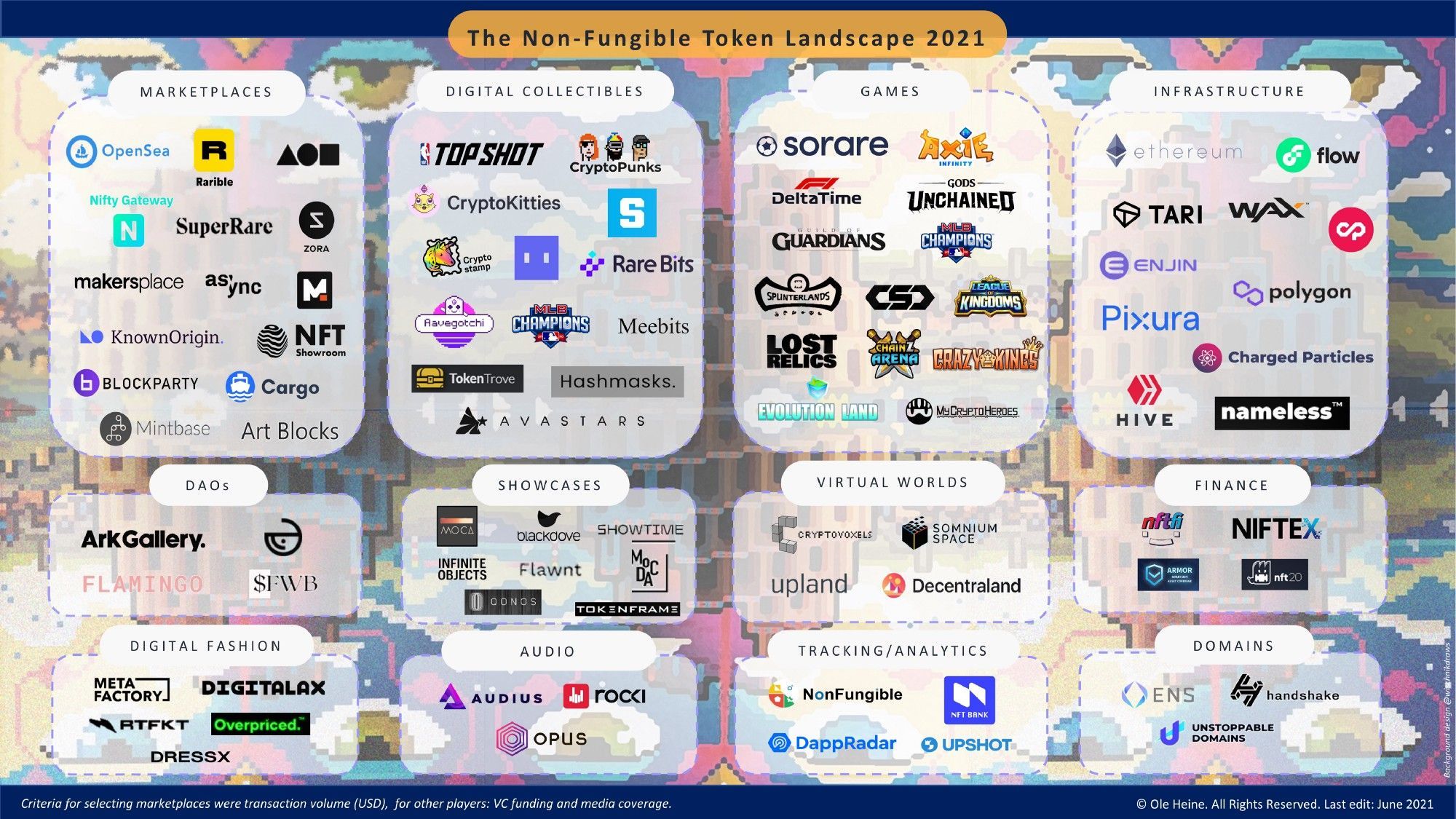
Bitcoin based NFTs
The concept of NFTs first came to be with Colored Coins in 2012 on Bitcoin's blockchain. The tokens were used to represent real world assets such as concert tickets however were not as efficient as originally hoped, as the Bitcoin network was not architected with NFTs in mind. It did bring about it a greater conversation around the potential for blockchain in serving as a ledger for real-life assets.
Counterparty was another early project launched on the Bitcoin blockchain in 2015. It is known as the original asset creation mechanism as it enabled users to create and trade digital assets. Geneva resident Shaban Shaame, released the first-ever blockchain-based mobile game, Spells of Genesis, using digital trading cards created on Counterparty.
Ethereum based NFTs
ERC-20
The first NFT project launched on the Ethereum blockchain was Etheria, through the ERC-20 token. This type of Ethereum token stands for 'Ethereum Request for Comment' (ERC) 20, and allows developers to create tokens that can interect with other tokens and applications on the Ethereum network.
Cryptopunks is a famous set of collectible NFTs developed through the ERC-20 token. A set of 10'000 were released in 2017, were all claimed nearly a week after release and began trading in a secondary marketplace. The most expensive Cryptopunk was sold at a Sotheby's auction for $11.7M in June 2021.

ERC-20 tokens were not best suited for creating NFTs, as they were created as standardized (fungible) tokens, which gave way to the creation of Ethereum tokens tailormade for NFTs.
ERC-721
The ERC-721 token enabled NFTs to store unique identifiers for every token to track their ownership and movements. The first NFT project launched using the ERC-721 token was the CryptoKitties game in 2017. The NFT represented a game-item and quickly gained in popularity. This caused overwhelming demand for the NFTs, which weighed on the Ethereum blockchain and impacted its ability to efficiently process transactions.
ERC-1155
This gave way to the creation of the ERC-1155 token or the Multi-Token Standard, which today is the most commonly used type of NFT token. It improves upon the ERC-721 token as it allows multiple NFTs to be sent in one single transaction. That is because the ERC-1155 token groups an infinite number of NFTs into a single smart contract.
An analogy with with a vending machine helps clarify the difference between the ERC-721 and ERC-1155 tokens. While ERC-1155 can hold an infinite variety of items (NFTs) in one vending machine (smart contract), ERC-721 requires one vending machine for each item sold.
This batching of transactions offers significant savings in gas costs and shortens the processing time for NFTs to be sent.
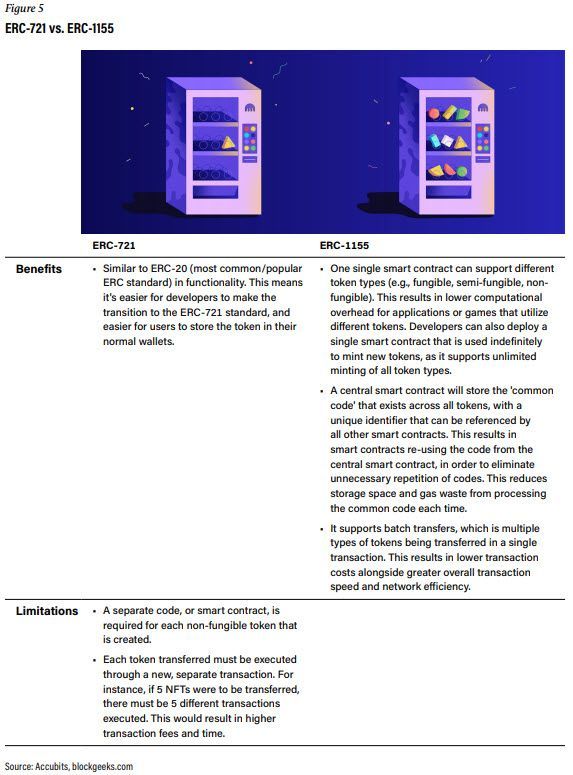
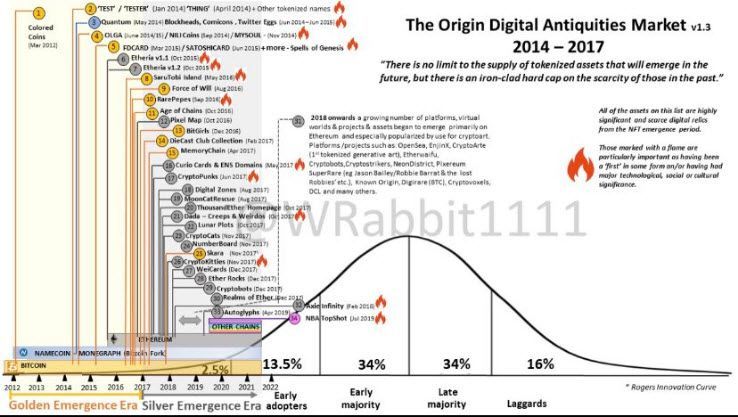
Other blockchain based NFTs
Although the Ethereum blockchain emits the most NFTs in the market, other blockchains are developing new NFT platforms and tokens to gain a greater share of the NFT market.
Solana and Cardano are among some of the blockchains expanding the NFT ecosystem. Cardano notably is becoming a popular network to build an NFT marketplace as its network is scalable, interoperable, and enjoys relatively higher transaction speed, due to its Proof-of-Stake consensus mechanism.

NFTs take the spotlight
The NFT ecosystem has seen a historic rise in trading in 2021. According to DappRadar - a company focused on tracking decentralized applications data - sales volume reached $10.7 billion in Q3, a 704% increase from Q2. On a year-over-year basis, trading volume increased by an astonishing 38'060% !
The graphs below illustrates the explosion of sales in the last two months and in the last four quarters.
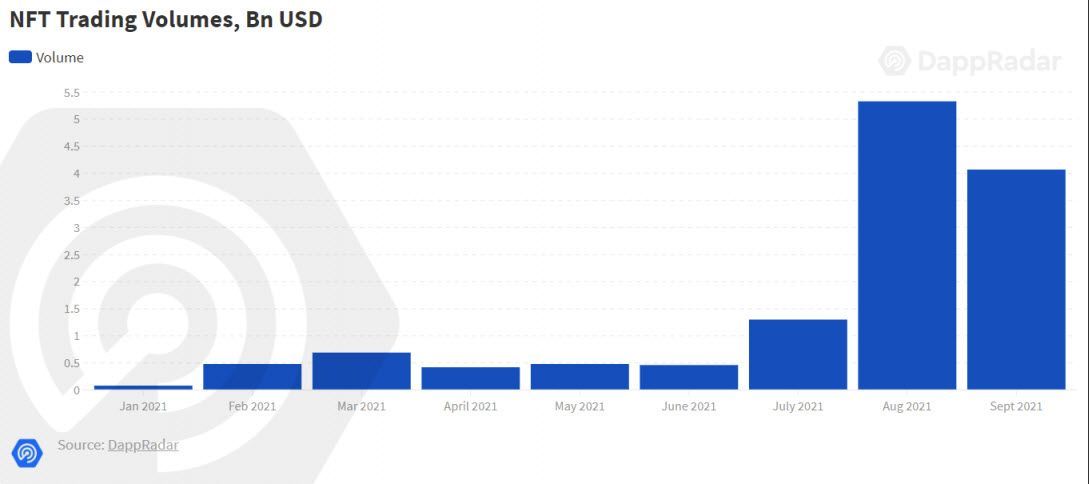
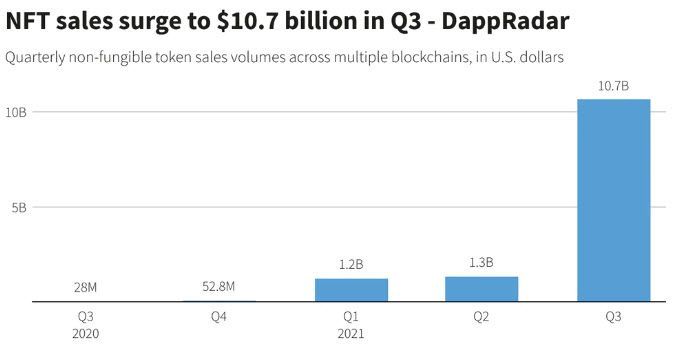
There are multiple reasons underpinning the colossal rise of NFTs in Q3. An increasing amount of NFT projects are associating themselves with brands and celebrities, which has helped stregnthen the social outlook of the NFT space. Collecitble NFT projects such as CryptoPunk or the Bored Ape Yacht Club (BAYC), have propelled the NFT space to becoming mainstream. Collectibles are by far the largest NFT sector in terms of sales value and volume as illustrated on the graph below.
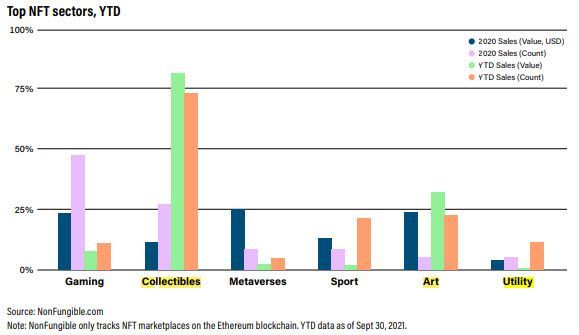
Visa purchased a CryptoPunk for $150'000 in August and asserted the relevance of NFTs in the upcoming digitally-led future. Furthermore, Sotheby's successfully completed the auction of 101 BAYC NFTs for $24.4 million in September. Top fashion brands like Burberry and Dolce & Gabbana also got involved in the sector in Q3 as they launched NFTs as game items and digital fashion collections respectively. There is therefore an undeniable mainstream signal provided by celebrities and big brands.
Another important factor that led to the explosion of NFTs in Q3 was the increased relevance of utility NFTs. These NFTs can enable their owners to gain access to new collectible NFT releases or to generate passive income. They reward their owners beyond simply owning the NFT itself.
An example of such an NFT project is CyberKongz which provides holders with passive income for holding their respective NFTs. A holder of a 'Kongz' NFT can receive yield in the native BANANA cryptocurrency. More on utility NFTs and their growing role in finance below.
The NFT space has undeniably experienced historic growth in the last few months. New types of NFTs are emerging and offering enticing value propositions whilst old NFTs are getting consolidated through various developments in the blockchain industry. It seems that NFTs have arrived on the grandstage and are looking to stay.
NFTs use cases 2022

NFTs in Finance & Banking
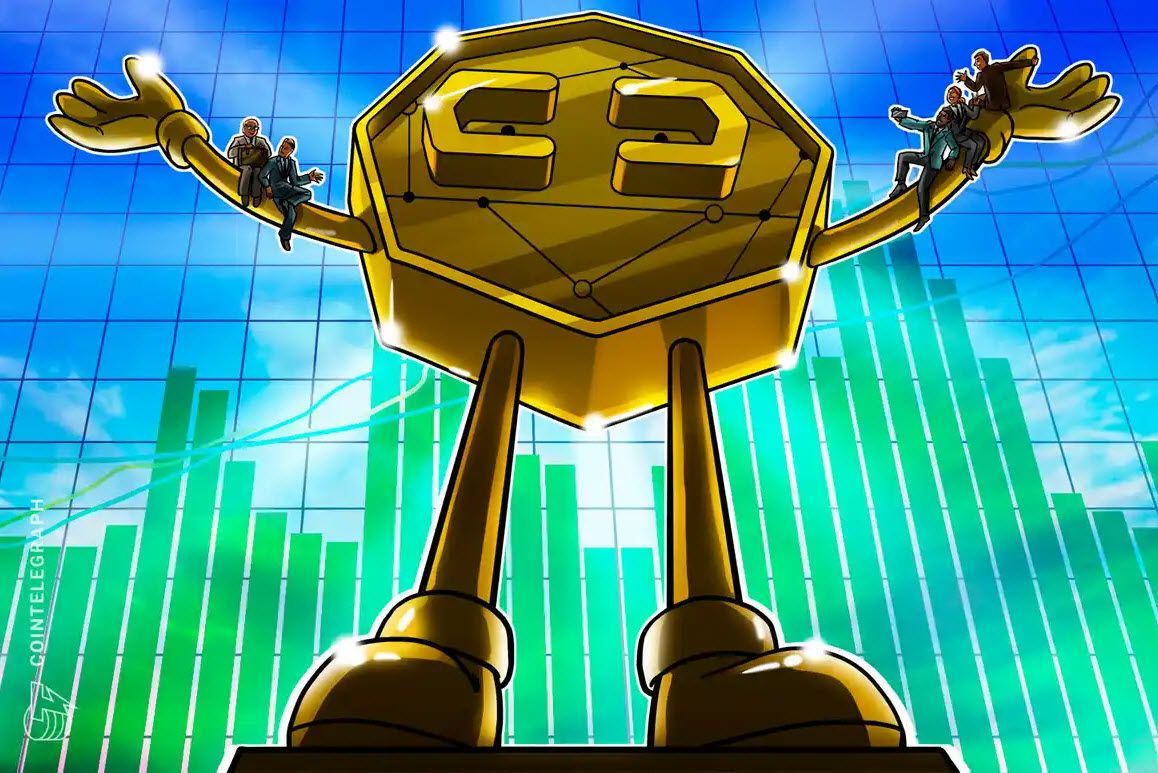
We have overviewed the revolutionary nature of the NFT technology, the varying ways in which it has been used, and the tremendous growth the NFT market has experienced this year. It is clear that NFTs have demonstrated the potential to create value by disrupting different industries for the better.
As such, it is imperative to overview the potential this technology has to add value to the financial sector, as well as how Banks in particular can position themselves strategically to tap into the ever-growing NFT market-share. It would be insightful to look at the example of Visa, another player in the financial services industry, and their recent involvement in the NFT space.
Visa
Visa purchased a CryptoPunk for $150'000 in September. Head of fintech Terry Angelos claimed that he sees "an emerging new category of commerce that we're calling NFT commerce". Visa isn't however planning to become an NFT investor and instead wanted to simply acquire "a piece of commerce memorabilia that we wanted as part of our collection".
It seems as though this transaction was a means for Visa to announce its intention to get involved in the new digital economy, as they do stand to be cut-out as a middleman for payments by cryptocurrencies. The company has therefore already helped crypto exchanges issue credit cards and is investigating the possibility of offering NFT liquidity to clients through special cards enabling the direct purchase of NFTs with fiat.
Angelos asserted that "as this goes mainstream, there's a demand for consumers to be able to just use their credit card or other debit cards to purchase an NFT". Although it has no direct activity linked to NFTs, Visa does seem to want to develop NFT related products or services.
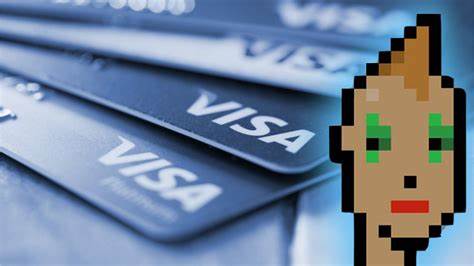
The Financial NFT Revolution
Finance is a sector that can benefit the most from the emerging use cases of NFTs in the coming years. NFTs can especially unlock even more potential within decentralized finance.
Proof of Ownersip
An example would be to record and verify the provenance of business contracts through NFTs. A bank could in theory leverage this to optimize Commodity Trade Finance activty by using NFTs as 'Letters of Credit'. NFTs could also confirm the existence of an insurance policy or a land title record to prove ownership of an asset.
Fractionalization
Expensive NFTs such as a digital art piece can be fractionalized into an investable product. This would enable several people to simulataneously invest into an expensive NFT (like buying shares in a company), as each fraction would represent partial ownership. Millions of dollars have been invested into virtual properties found in Metaverse, where rights to the property are sold through NFTs. This NFT could generate yield by renting the virtual property to other users.
Collateralization and Lending
An interesting future use case of NFTs that has the potential to take off is that of collateralization and lending, as the vast majority of lending protocols are collateralized in DeFi. For example, an NFT representing a piece of art, virtual land or tokenised real estate could be supplied as collateral and enable the borrowing of loans against it.
Being able to post an NFT as collateral to take out a loan seems like a natural fit in the finance space - Sasha Fleyshman, Portfolio Manager at Arca (Investment Management firm for digital assets)
AlchemyNFT’s Zhang predicts a future where all tradable and non-fungible rights will be tokenized via NFTs, which would prevent them from being locked in a single platform. These tokenized rights could be traded on the market and integrated across systems, forming frictionless global markets that are effortlessly integrated.
While all this may sound a bit pie-in-the-sky, finance has always been one of the most creative industries when it comes to experimenting with assets, derivatives, and emerging markets,” said Zhang
An example of an existing NFT platform enabling this mechanism is Drops.
A multi-featured platform that enables NFT holders to trustlessly borrow fungible assets including Ether and stablecoins against their NFT assets. These loans can be used by borrowers to use in staking or yield-farming.
Drops plans to have yield-farming vaults built into their platform by late 2021, which would enable NFT holders to stake their NFTs and earn quantifiable returns. The rationale behind this protocol is to allow NFT holders to reduce the opportunity cost of simply holding the next generation of financial assets and enable the sector to flourish.
Other projects intersecting Defi and NFTs
Provide liquidity provision tokens, or claims on tokens supplied by market makers as NFTs. There is $1.3 billion in value currently represented as NFT assets from a single protocol
Insurance contracts underwritten by Nexus Mutual being sold as NFTs on Rarible
Investment contracts being programmed into NFTs for improving the transparency and transfer of project tokens
Combinations of different fungible and non-fungible tokens into a "basket" of NFTs
Existing NFTs being combined with interest-bearing ERC20 tokens
One of the pioneering platforms for NFT collateralized loans. Allows users to earn a yield by lending out ETH to users who put up their non-fungible tokens as a collateral.
Launched in May 2020, it is a platform that enables the fractionalization of NFTs into several investable units
An NFT index fund provider

NFT platforms

Tezos
Tezos is a blockchain that supports the creation and distribution of NFTs. It uses the Proof-of-Stake (PoS) system and therefore operates without the large energy requirements needed for other type of blockchains. As such, it only costs a fraction of its native token or 'tez' to create or 'mint' an NFT on Tezos. Once created, an NFT can be sold or collected all in a single marketplace built on the Tezos blockchain. The most popular ones are 'Hen', 'Kalamint', 'Bazaar'.
The low transaction fees and energy requirements is why Tezos has become a popular option for artists and major brands to build their NFT projects. Automative racing powerhouse McLaren announced in June that it would build an NFT platform on the Tezos blockchain.
In fact, Tezos will be presenting a multi-faceted Art NFT exhibition at Art Basel Miami Beach 2021. The event ranks among the world's most important art events, regularly showcasing new artists and trends. Last month, Art Basel welcomed Art NFTs for the first time. This was a sigificant milestone for the acceptance of NFTs as a medium of art, on par with physical paintings and sculptures.


